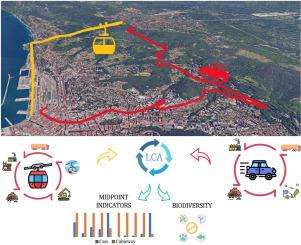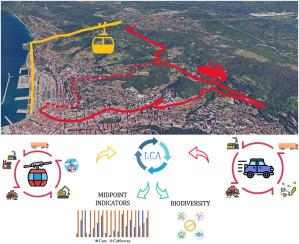The environmental and biodiversity impacts of a new cableway system: A comprehensive life cycle assessment
IF 9.7
1区 环境科学与生态学
Q1 ENGINEERING, ENVIRONMENTAL
引用次数: 0
Abstract
Cars are still used as the primary mode of transportation for daily commuting, with their emissions significantly affecting urban air quality, contributing to overall greenhouse gas emissions. Efforts to reduce car dependency have led to exploration of alternative transportation options such as cableway systems in urban areas. However, limited information exists regarding the environmental impacts and biodiversity implications of such systems. This study conducted a comparative life cycle assessment between a proposed cableway system for the city of Trieste, Italy and its current car transportation mode. The analysis considered both daily operational profiles and passenger occupancy rates of the cableway system. Drawing from similar cableway systems worldwide, it was calculated that the proposed Trieste cableway would accommodate 2007 daily passengers, on average. Results from the environmental assessment revealed that the cableway's operational phase had by far the greatest impact on all environmental categories, followed by its construction and by land clearance. Additionally, the use phase was found to be the major cause for most biodiversity loss, particularly towards terrestrial ecosystems. Comparisons of life cycle GHG emissions between the cableway and car transportation indicated that the cableway system would be a preferable option if the daily average passengers would reach at least 3,908, which is almost double than the expected ones. Furthermore, the cableway system exhibited larger environmental impacts across most categories compared to current car transportation. Thus, this study challenges the perception that the cableway system is a more sustainable option compared to conventional modes of transport, as additional factors need to be considered for a broader overview of the environmental performances.


新索道系统对环境和生物多样性的影响:综合生命周期评估
汽车仍然是人们日常通勤的主要交通工具,其排放的废气严重影响了城市空气质量,加剧了整体温室气体排放。为减少对汽车的依赖,人们开始探索替代交通方式,如城市地区的索道系统。然而,有关此类系统对环境影响和生物多样性影响的信息十分有限。本研究对意大利的里雅斯特市拟建的索道系统和目前的汽车运输模式进行了生命周期比较评估。分析考虑了索道系统的日常运行概况和乘客占用率。根据全球类似索道系统的计算结果,拟建的的里雅斯特索道平均每天可容纳 2 007 名乘客。环境评估结果表明,索道运营阶段对所有环境类别的影响最大,其次是施工阶段和土地清理阶段。此外,使用阶段也是造成生物多样性丧失的主要原因,尤其是对陆地生态系统的影响。对索道和汽车运输的生命周期温室气体排放量进行比较后发现,如果索道系统的日均客流量至少达到 3 908 人次(几乎是预期客流量的两倍),那么索道系统将是更可取的选择。此外,与目前的汽车运输相比,索道系统在大多数类别中都表现出更大的环境影响。因此,本研究对 "与传统交通方式相比,索道系统更具可持续性 "这一观点提出了质疑,因为要更全面地了解索道系统的环境表现,还需要考虑其他因素。
本文章由计算机程序翻译,如有差异,请以英文原文为准。
求助全文
约1分钟内获得全文
求助全文
来源期刊

Journal of Cleaner Production
环境科学-工程:环境
CiteScore
20.40
自引率
9.00%
发文量
4720
审稿时长
111 days
期刊介绍:
The Journal of Cleaner Production is an international, transdisciplinary journal that addresses and discusses theoretical and practical Cleaner Production, Environmental, and Sustainability issues. It aims to help societies become more sustainable by focusing on the concept of 'Cleaner Production', which aims at preventing waste production and increasing efficiencies in energy, water, resources, and human capital use. The journal serves as a platform for corporations, governments, education institutions, regions, and societies to engage in discussions and research related to Cleaner Production, environmental, and sustainability practices.
 求助内容:
求助内容: 应助结果提醒方式:
应助结果提醒方式:


